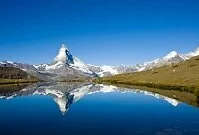Geography, Weather, & Wildlife of Switzerland
Geography

Matterhorn
Switzerland is a landlocked country in the western half of Central Europe (or arguably in Western Europe). Switzerland borders France (west), Italy (south), Liechtenstein (east), Austria (east), and Germany (north).
Geographically, Switzerland is very mountainous as the Alps peak in this area. The country, however is also consumed with the rivers rushing down from these mountains so there are a number of river valleys and lakes through the country. Generally speaking, the north and west are much flatter than the south and it is in these regions where much of the population lives and nearly every significantly-sized city is located. However, the numerous valleys and alpine lakes allow settlements throughout the country, although most can only grow as far as the mountains allow them to.
Weather

Blenio Valley
Switzerland's seasons are very distinct and the country has a great number of geographical variations, making generalizations somewhat difficult. Winters (December-March in the mountains) can be cold, as the mountains are covered in snow. In the Alps, temperatures tend to be consistently below freezing, but in the valleys and major cities, temperatures tends to move from below to above freezing during these months, giving them a combination of rain and snow.
The spring and fall (autumn) are ideal in the cities and valleys, but many of the mountain passes are snowed in.
From a temperature standpoint, summers are the ideal time in Switzerland with averages between 60-70˚ F (16-21˚ C) in the mountains and 65-75˚ F (18-24˚ C) in the cities of Zurich and Geneva, but daytime highs typically reach another 10-15˚ F (5-11˚ C) hotter in the cities.